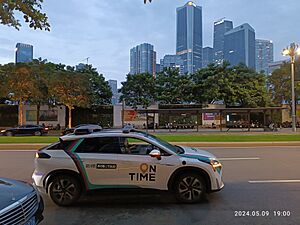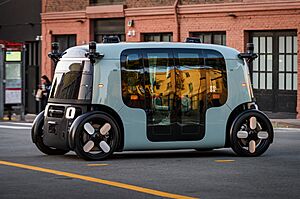Robotaxi facts for kids
A robotaxi is like a regular taxi, but it drives itself! It's a special type of autonomous car (meaning it can drive without a human) that works for companies that offer rides, similar to services like Uber or Lyft.
Many experts believe robotaxis could become a very popular way to get around, especially in cities. They could make roads safer, reduce traffic congestion, and even help with parking problems. Since most robotaxis are electric cars, they can also help lower pollution and save energy.
Robotaxis might make rides cheaper because there's no human driver to pay. This could make it easier for more people to use transportation services instead of owning their own cars. However, there have been some challenges. For example, in 2023, some robotaxis caused traffic jams when they lost their internet connection. Also, some didn't properly stop for emergency vehicles. There has been one serious accident involving a robotaxi, which happened in 2018 with a test vehicle.
Even though some people thought robotaxis would be everywhere by 2018, they are still being tested. Many trials are happening in cities worldwide, and some are even open to the public. People are still working on making the technology perfect and ensuring everyone trusts these self-driving cars.
Contents
How Robotaxis Work
Vehicle Technology
Robotaxis are special cars fitted with lots of high-tech equipment. They use Lidar (which uses lasers to measure distance), cameras, and other sensors to "see" the world around them. These sensors help the car understand where it is, what's nearby, and how to navigate safely.
Early robotaxis were very expensive to build, costing hundreds of thousands of dollars. This was because they were custom-made and used specialized sensors. However, the cost of some parts, like LIDAR, has dropped a lot. For example, in 2021, Waymo said their cars cost about $180,000 each. Baidu announced in 2021 that it could make robotaxis for around $77,665. Tesla has even talked about making a robotaxi that costs less than $25,000.
Where Robotaxis Operate
Robotaxis usually operate only in specific areas called "geo-fenced" zones or Objective Design Domains (ODD). These are special zones where the robotaxis are allowed to drive and can provide safe service.
As of April 2024, Baidu's Apollo Go service in China had given over 6 million rides, making it one of the busiest robotaxi services. Other companies like AutoX, DiDi, Pony.ai, and WeRide also operate in many Chinese cities. In the United States, Waymo is a leading provider, with services in San Francisco, Phoenix, and Los Angeles. A study in 2024 showed that Waymo cars had 85% fewer crashes that caused injuries compared to human-driven cars.
Besides regular cars, there are also larger self-driving shuttle buses. These can carry 6 to 10 passengers and travel on fixed routes with specific stops, usually at slower speeds.
Challenges for Robotaxis
It's not just about making the technology work perfectly. People also need to feel comfortable and safe using robotaxis. Some people worry about how reliable these cars are and if they might have system failures or get into accidents. They also wonder if robotaxis can handle tricky city environments or bad weather conditions.
Getting Licenses
Before robotaxis can operate, companies need special permits and licenses from the government. For example, in February 2018, Waymo received a permit to operate in Arizona.
In California, the California Public Utilities Commission (CPUC) started giving permits in February 2022. These permits allowed companies like Cruise and Waymo to offer passenger services, first with a safety driver present, and later without one. In August 2023, the CPUC allowed Waymo and Cruise to charge money for driverless rides in San Francisco.
China also started giving permits. In April 2022, Baidu and Pony.ai got the first permits to use robotaxis without safety drivers on public roads in a part of Beijing. In December 2023, China set up rules for commercial robotaxi operations, including how many robotaxis one remote operator can manage.
History of Robotaxis
Early Trials
The idea of robotaxis isn't new. In August 2016, Uber announced it would start testing its self-driving taxis in Pittsburgh. Just a week later, a company called NuTonomy launched its own robotaxi service in Singapore, though it was only for a select group of people. Uber's public launch in Pittsburgh happened in September 2016.
NuTonomy later partnered with other companies like Grab and Lyft to expand its services. In August 2017, Cruise Automation, a company owned by General Motors, started a test service for its employees in San Francisco.
Timeline of Testing and Service
Many companies have been testing and launching robotaxi services around the world. Here are some key moments:
- August 2016: NuTonomy started a test service in Singapore with safety drivers.
- September 2016: Uber launched its self-driving taxi service in Pittsburgh, open to the public, with safety drivers.
- April 2017: Waymo began large-scale robotaxi tests in Phoenix, Arizona, with drivers monitoring the vehicles. They started some driverless tests later that year.
- December 2018: Waymo launched Waymo One, its first self-driving taxi service for paying customers in Arizona.
- April 2019: Pony.ai started a pilot program for employees in Guangzhou, China.
- April 2020: Baidu opened its robotaxi trial in Changsha, China, to the public for free rides.
- June 2020: DiDi robotaxi service began operating in Shanghai.
- December 2020: AutoX launched a driverless robotaxi trial in Shenzhen, China, which opened to the public in January 2021.
- February 2021: Waymo One expanded its limited robotaxi service to some San Francisco suburbs for employees.
- February 2022: Cruise opened its driverless cars in San Francisco to the public.
- February 2023: Zoox, owned by Amazon, carried passengers in its robotaxi for the first time in Foster City, California.
- August 2023: Waymo and Cruise were allowed to charge for driverless rides in San Francisco.
- April 2024: Baidu Apollo, AutoX, Pony.ai, DiDi, and WeRide were operating in many cities, with hundreds of robotaxis. Baidu Apollo had driven over 100 million kilometers without a major accident.
- July 2024: Baidu's Apollo Go robotaxis became very popular in Wuhan, China, with fares as low as 4 Chinese yuan (about 55 US cents), much cheaper than human-driven taxis.
- August 2024: Baidu’s Apollo Go robotaxis in Wuhan could operate fully without any safety personnel on board in most areas. The company recorded 899,000 rides in the second quarter of 2024.
Major Robotaxi Companies
Uber Advanced Technology Group
Uber started working on self-driving cars in 2015. In September 2016, they began testing robotaxis in Pittsburgh. These were modified Ford Fusions. They later expanded tests to San Francisco and Arizona.
In March 2018, Uber paused its self-driving tests after an accident in Arizona where a pedestrian was hit by an Uber vehicle. Uber later sold its self-driving car division to another company called Aurora Innovation in January 2021.
Waymo
Waymo is a company that started as Google's self-driving car project. In early 2017, Waymo began a large public test of robotaxis in Phoenix, Arizona, using Chrysler Pacifica Hybrid minivans. They also partnered with Lyft.
In November 2017, Waymo started operating some of its cars in Arizona without a safety driver. By December 2018, Waymo launched its Waymo One service for paying customers. As of 2021, their autonomous taxi service was also running in San Francisco. In December 2022, Waymo applied for a permit to operate self-driving taxis in California without a human backup driver.
Baidu Apollo
In September 2019, Baidu, a major Chinese tech company, launched its Apollo Go robotaxi service. It started with 45 self-driving cars and has since grown to operate in more than 10 Chinese cities.
In August 2022, Baidu made a big step by getting the first permits in China to use fully driverless taxis in Wuhan and Chongqing. In May 2024, Baidu showed off its new robotaxi, which can be made for under $30,000. They also announced that Apollo had driven over 100 million kilometers without major accidents.
By August 2024, Apollo Go had 400 robotaxis operating fully autonomously in Wuhan, offering 24/7 service to millions of people.
GM Cruise
In January 2020, Cruise, a company owned by General Motors, showed off the Cruise Origin. This is a special driverless vehicle designed for ride-hailing services.
In February 2022, Cruise started its driverless taxi service in San Francisco. They also asked U.S. regulators for permission to build and use a self-driving vehicle without human controls. Cruise has partnered with Honda to roll out mobility services in Tokyo.
However, there have been some issues with Cruise vehicles. In October 2023, a Cruise vehicle collided with a pedestrian and dragged them a short distance. Because of this and concerns that the company didn't share all details with regulators, California regulators took away Cruise's license to operate these cars. Cruise recalled all 950 of its vehicles in November 2023. Safety concerns had also been raised about how Cruise vehicles behaved around children and construction sites.
Tesla
Tesla's CEO Elon Musk has talked about Tesla having robotaxis on the road for several years. In August 2024, Tesla showed two new vehicles: the two-seater Tesla Cybercab and the larger 14-seater Tesla Robovan. The company also said that all of its other car models could be used as robotaxis after a software update and getting government approval, possibly in California and Texas by 2025.
Other Developments
Many car makers and tech companies have announced plans to develop robotaxis. Some notable partnerships and plans include:
- The startup Zoox announced in 2015 its goal to build a robotaxi from scratch.
- BMW and Fiat Chrysler Automobiles partnered with Intel and Mobileye in 2016 to develop robotaxis.
- Baidu teamed up with Nvidia in 2016 to work on autonomous cars.
- Daimler AG and Bosch joined forces in 2017 to create software for robotaxi services.
- The Renault–Nissan–Mitsubishi Alliance partnered with Transdev and DeNA in 2017 to develop robotaxi services.
- Honda showed an autonomous concept car called NeuV in 2017, designed to be a personal robotaxi.
- Ford planned to develop a robotaxi by 2021 and invested in the startup Argo AI, which was later closed in 2022.
- Lyft and Ford partnered in 2017 to add Ford's self-driving cars to Lyft's network. Lyft's self-driving division was sold to Toyota in 2021.
- Delphi bought the startup NuTonomy in 2017.
- Didi Chuxing partnered with the Renault–Nissan–Mitsubishi Alliance and other carmakers in 2018 to explore robotaxi services in China.
See also
- Apolong
- Self-driving car




